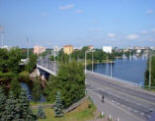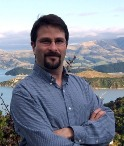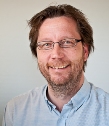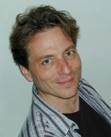|

|
|
Keynote speakers
John Doherty (Australia)
Presentation topic:
Environmental modeling - encapsulating what we known and
quantifying
what we don't" |
 |
Dr.
John Doherty works primarily for himself as a private consultant. He also works
in a part-time capacity for the National Centre for Groundwater Research
and Training at Flinders University Australia. There is a considerable
overlap between his research and consulting interests. These are focused
mainly on the following topics, all of which attempt to serve the
greater purpose of maximizing the use environmental modeling in the
decision-making context:
-
Solution of the inverse problem of model calibration in ways that are
numerically efficient but that allow maximum usage of both field data
and expert knowledge;
-
Quantification of the uncertainty associated with model predictions of
management interest;
-
Development of a theoretical understanding of the benefits and costs of
simplicity vs. complexity in environmental models;
-
Appropriate use of models in the environmental decision-making process.
|
Aaron Packman (USA)
Presentation topic:
Overview of surface-groundwater interactions in the context of
river
degradation, water quality, and ecosystem processes |
 |
Dr.
Aaron Packman is a Professor in the Department of Civil and
Environmental Engineering, McCormick School of Engineering and Applied
Sciences, Northwestern University. His research focuses on
environmental and microbial transport processes, with particular
emphasis on understanding the basic processes that control interfacial
transport in aquatic systems and the coupling of physical transport
processes with biological and biogeochemical processes in dynamic
natural environments such as rivers. Dr. Packman’s work is highly
collaborative and encompasses basic fluid mechanics, particle transport
and morphodynamics, microbiology, and aquatic and surface chemistry.
Important applications include contaminant transport and water quality,
microbial habitat conditions and benthic microbial ecology, nutrient and
carbon cycling, ecosystem degradation and restoration, control of
biofilm-based infections, and the transmission of waterborne disease.
Dr. Packman has received several awards for his work, including Career
awards from the U.S. National Science Foundation and National Institutes
of Health, and the Huber Research Prize from the American Society of
Civil Engineers. He is currently an associate editor for the leading
aquatic sciences journal Limnology and Oceanography – Fluids and
Environments, and is the Vice-President of the International
Association for Sediment Water Science. He is also very active on
technical committees and panels addressing sediment contamination,
hydrologic synthesis, and waterborne disease transmission.
|
Per Gustav Stålnacke (Norway)
Presentation topic:
How slow can it be? Spatial and temporal considerations on
nutrient
retention from source to river mouth |
 |
Dr. Per
Stålnacke is the head of the department of 'Water quality and hydrology'
at Bioforsk Soil and environment in Norway and also vice-president of
the IAHS ICWQ. His research interest is on integrated water resources
management and the policy-science interface. Besides, he has
considerable experiences in assessments of nutrient fluxes at a river
basin scale. There is, according to him, a huge research need to better
quantify the hydrological pathways and development of better tools to
assess and improve the understanding of how long it can take before we
can observe improved water quality due to implemented mitigation
measures. These are the apparent needs in relation to the WFD and the
HELCOM BSAP. Stålnacke will in his presentation show and discuss some
very recent results on nutrient retention in the Baltic Sea drainage
area and time trends in selected rivers in Baltic Sea and Europe.
|
Nikolai Friberg
(Denmark)
Presentation topic:
Restoring stream ecosystems in a changing climate |
 |
Dr. Nikolai Friberg is Deputy Head of the Department of Bioscience at
Aarhus University. He has more than 20 years research experience with in
the field of freshwater ecology from working both in Denmark and abroad.
His main focus of research has been on applied issues and how
anthropogenic disturbance impact freshwater communities. His science has
evolved around community ecology and centered on three overall themes:
 The influence of habitats and anthropogenic stressors (organic
pollution, pesticides etc.) on stream biota and ecosystem
processes;
The influence of habitats and anthropogenic stressors (organic
pollution, pesticides etc.) on stream biota and ecosystem
processes;
 Influence of riparian areas and catchment land use on stream communities
and biological structure, including effects of restoration measures;
Influence of riparian areas and catchment land use on stream communities
and biological structure, including effects of restoration measures;
 Effects on climate change on stream ecosystem structure and functioning
including food web architecture;
Effects on climate change on stream ecosystem structure and functioning
including food web architecture;
His main research interest recently relates to the interaction among
organisms across levels of organization and how this will influence
ecosystem processes, including recently how food webs change in relation
to climate. Currently he is involved as work package leader in a new EU
FP 7 project, REFORM, on detecting habitat degradation and developing
evidence based ways of restoring rivers. His is currently the president
of NORBS (Nordic Benthological Society) and the Danish representative in
CHIN and Euraqua.
Cintia Bertacchi Uvo (Sweden)
Presentation topic:
The interacting system of climate and hydrology |
 |
Cintia Bertacchi Uvo is a Professor at the Department of Water Resources
Engineering, Lund University. Her research interests lie on how climate
and hydrology affect, interact and relate to each other in different
time and space scales, typically from monthly to decadal. Prof. Uvo’s
work is essentially interdisciplinary and dedicated to understanding of
processes that are then statistically modeled and applied. In the latest
years, the development of seasonal hydrological forecast based on
climate variability has included a large part of her research.
Her work is very collaborative and international. Applications of her
work have been made in many parts of the world and in collaboration with
diverse institutions worldwide.
Prof. Uvo is also very active in education of doctoral students and has
created several international courses with the objective of stimulating
young researcher to comfortably walk on the bridge that connects climate
and hydrology.
Back to top |